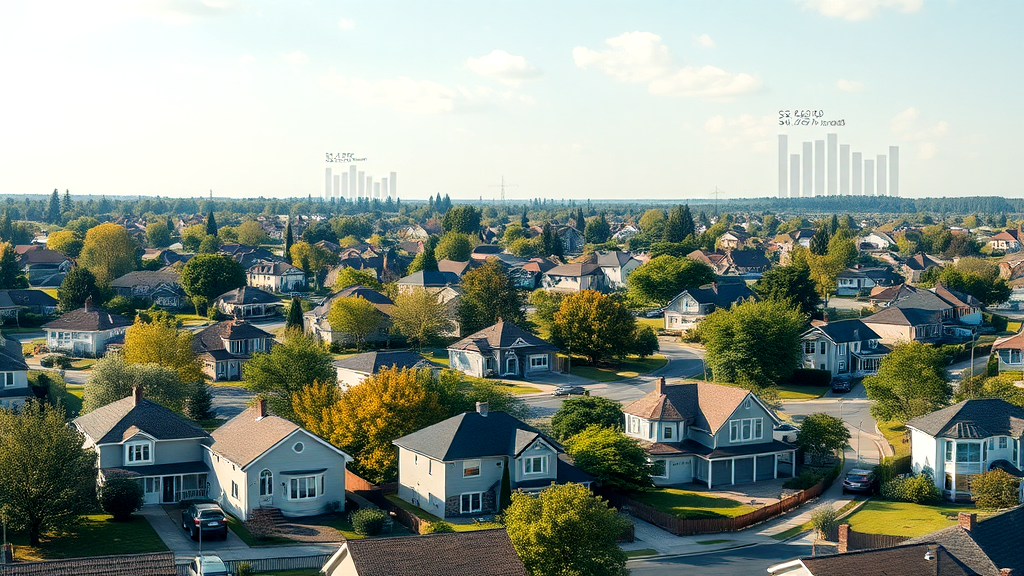Understanding the Income and House Price Ratio
The income and house price ratio is a crucial tool for understanding home affordability. It compares the median home price to the median household income, revealing how accessible homes are for typical buyers. Recently, this ratio has shown troubling trends. In 2022, the average home price soared to 5.6 times the median income, the steepest since the 1970s. This gap between home prices and median household income highlights growing challenges. With home prices rising faster than incomes, many find it hard to manage their monthly mortgage payments. Understanding this ratio helps us navigate our housing options wisely and make informed financial decisions.
Key Takeaways
-
The income and house price ratio indicates how accessible homes are for buyers.
-
In 2022, the average home price was 5.6 times the median household income.
-
Rising home prices have outpaced income growth, causing affordability challenges.
-
Mortgage payments should ideally stay below 28% of gross income for financial stability.
-
Improving your credit score can lead to better mortgage rates and lower monthly payments.

Historical Trends in Home Prices
Home prices have historically fluctuated due to various economic influences. The income and house price ratio has become a critical measure of affordability, especially in recent years. In 2022, this ratio reached historic highs, indicating that home prices significantly outpaced income growth. While low mortgage rates during the pandemic fueled price increases, rising interest rates in 2023 have tempered growth.
Regions like San Francisco face severe affordability issues, with ratios soaring over 11.0, while places like McAllen, TX, remain more accessible. Understanding these trends helps us navigate the housing market better. For deeper insights into potential market shifts, check out my thoughts on whether the housing market will crash in 2025.

Economic Factors Impacting Home Affordability
Key economic influences on home affordability include interest rates, local economies, and income levels. As interest rates rise, monthly mortgage payments become less manageable, impacting our ability to buy homes. Markets like San Francisco face extreme challenges, where the income and house price ratio exceeds 11.0, making it hard for many to afford homes. Meanwhile, regions like the Midwest offer more accessible options with lower ratios.
The disparity in median home prices across the country creates stark contrasts. For instance, soaring prices in coastal areas make homeownership seem out of reach for many. Understanding these dynamics helps us make informed decisions in a fluctuating housing market, ensuring that we find homes that fit our budgets.
Analyzing Median Household Income Levels
The examination of median household income levels reveals a significant gap in affordability across the U.S. For instance, in high-cost areas like San Jose, the income and house price ratio highlights a stark contrast with an income of $146,000 and home prices averaging $1.8 million. In contrast, McAllen, TX, shows a more manageable scenario with a $45,000 income and homes around $141,000.
These disparities underscore the challenges many face in achieving home affordability. Furthermore, rising monthly mortgage payments, driven by interest rates, complicate the situation even more. Understanding these variances can guide us in making informed choices when navigating the housing market, ultimately helping us secure homes that fit within our financial means.
Regional Variations in Housing Market Affordability
Regional differences in housing market affordability reveal striking contrasts across the nation. For instance, coastal areas like Miami and New York often grapple with higher income and house price ratios, making homeownership elusive. In these regions, a high ratio underscores the challenge of securing affordable housing.
Conversely, Midwest markets, such as Detroit and Cleveland, typically showcase more favorable conditions. Lower income and house price ratios here mean homes are often within reach for many buyers.
Understanding these regional variations helps us navigate affordability challenges. By analyzing local economic conditions, we can make informed decisions that enhance our chances of achieving home affordability while considering factors like credit scores and monthly mortgage payments.

How Mortgage Payments Impact Affordability
Mortgage payments play a crucial role in determining housing affordability. The income and house price ratio directly influences how much we can afford. If mortgage payments take up a large portion of our income, financial strain increases. This can lead to difficult choices between essential expenses and housing costs.
Interest rates and loan terms affect our monthly payments, impacting our overall budget. A higher credit score can lower interest rates, helping us manage payments better. Additionally, property taxes vary, adding another layer to the affordability equation.
Understanding these factors allows us to make informed decisions, ensuring our housing costs remain manageable while striving for stability in our financial lives.
The Role of Property Taxes in Housing Affordability
Property taxes play a key part in evaluating housing affordability. These taxes vary widely across regions, directly impacting our overall housing costs. In areas with high property taxes, the burden increases, making it harder for us to balance our budgets. This situation can exacerbate the income and house price ratio, pushing many families into financial strain.
Furthermore, when property taxes rise, homeowners may find themselves with less disposable income, affecting their ability to save or invest. Understanding local tax rates is essential in our housing journey. We should always factor these taxes into our calculations. This is crucial for anyone considering a home purchase, especially in high-cost areas.
For insights on the market, visit Jordan Link’s market update.

The Role of Credit Scores in Home Buying
Understanding how credit scores affect our journey in home buying is crucial. A higher score often results in lower interest rates, making mortgages more accessible and affordable. This can significantly enhance our chances of qualifying for a loan that fits our budget.
Additionally, good credit can improve our income and house price ratio, allowing us to target homes that align better with our financial situation.
Here are some key aspects to consider:
-
Higher scores lead to better mortgage terms.
-
They reduce monthly payments, easing financial strain.
-
Insurers may offer lower premiums based on credit.
-
Some lenders prioritize credit scores over other factors.
-
We can improve our scores through timely payments.
By focusing on our credit score, we open doors to better home financing options.

Understanding the 28/36 Rule for Budgets
The framework of the 28/36 rule for budgets helps us manage our finances effectively. This guideline suggests that our housing costs should not exceed 28% of our gross income. Additionally, all debts must remain under 36% of our income.
Following this rule ensures a sustainable approach to homeownership. It allows us to enjoy our homes without risking financial strain. It’s essential to assess our income and house price ratio when making housing decisions. By doing so, we can avoid overextending ourselves.
Understanding the balance between what we earn and what we spend on housing is crucial. Ultimately, this helps us maintain a stable financial future while enjoying our living spaces.

Strategies for Saving for a Down Payment
When we think about ways to save for a down payment, several strategies come to mind. First, we should set clear savings goals based on our income and house price ratio. This helps us know how much to save each month. Reducing discretionary spending is another effective tactic. Cutting back on dining out or unnecessary subscriptions can add up quickly.
Additionally, exploring assistance programs for first-time buyers can be beneficial. Many programs provide grants or low-interest loans that ease the burden. Lastly, improving our credit scores can lead to better mortgage rates, making homeownership more affordable. Focusing on these strategies helps us navigate the challenges of saving for a down payment.
Three Tips for Improving Home Affordability
Improving our situation regarding the income and house price ratio can be achieved through a few strategic moves.
First, we should focus on enhancing our credit scores. A higher score can qualify us for better mortgage rates, which reduces overall costs.
Next, exploring different regional markets can reveal areas with more favorable price-to-income ratios. This approach allows us to find homes that fit our budgets better.
Lastly, utilizing financial tools and seeking expert advice can help us make informed decisions. Budgeting properly and understanding available resources can lead to smarter investments in our future homes. By applying these tips, we can tackle the challenges of homeownership more effectively.

Conclusion
Understanding the income and house price ratio is crucial for navigating today’s housing market. With rising home prices and stagnant wages, many families find themselves priced out of homeownership. By analyzing trends, we can identify potential paths to improve affordability and make informed choices.
We can take proactive steps towards homeownership by focusing on improving our credit scores and exploring regions with better price-to-income ratios. It’s never too late to set savings goals and cut unnecessary expenses. Together, we can build a stable financial future, making homeownership a reality for more of us.
FAQ
-
What is the income and house price ratio?
The income and house price ratio measures housing affordability. It compares median home prices to median household incomes. A higher ratio indicates less affordability. For example, a ratio of 5.6 means homes cost 5.6 times the median income. -
How do mortgage payments affect home affordability?
Mortgage payments depend on interest rates and loan terms. The 28/36 rule suggests housing costs should be less than 28% of gross income. If mortgage payments exceed this, it can strain our budgets and lead to financial difficulties. -
Why are some regions more affordable than others?
Regional variations arise from local economic conditions and housing market dynamics. Coastal areas often face high demand and limited supply, leading to higher prices. In contrast, Midwest regions usually have more affordable housing options. -
What role do credit scores play in home buying?
Credit scores impact mortgage eligibility and interest rates. Higher scores can lead to lower interest rates. This, in turn, decreases monthly payments, making homes more affordable for us. -
How can we improve home affordability?
Improving credit scores can help us secure better mortgage rates. Exploring different regional markets may lead to better price-to-income ratios. Utilizing financial tools and expert advice can further enhance our affordability strategies.


 Facebook
Facebook
 X
X
 Pinterest
Pinterest
 Copy Link
Copy Link




